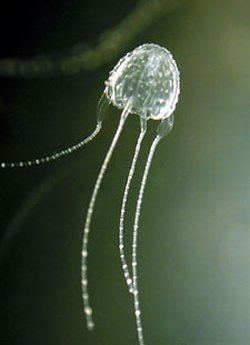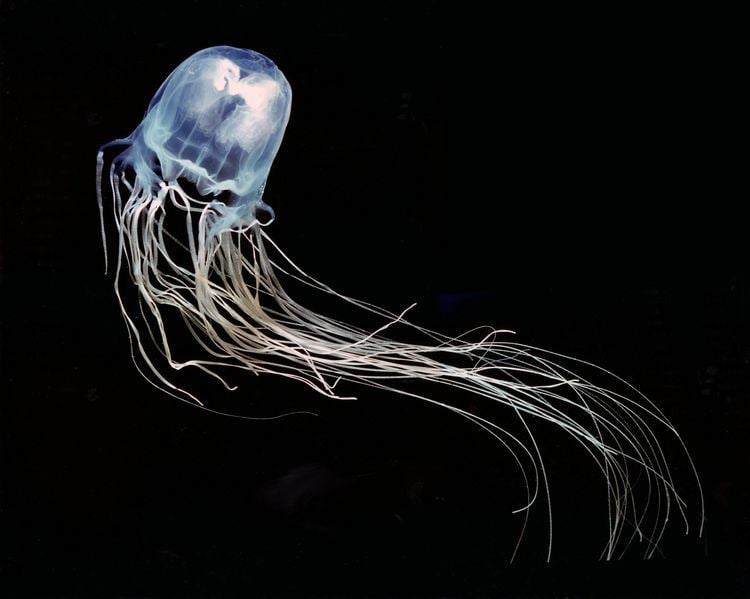 | ||
Representative species Carukia barnesi, Malo kingi, Malo maximus | ||
Irukandji jellyfish world s deadliest fishing
Irukandji jellyfish (/ˌɪrəˈkændʒi/ IRR-ə-KAN-jee) are the smallest and one of the most venomous jellyfish in the world. They inhabit the marine waters of Australia, Florida and the U.S.A. They are able to fire their stingers into their victim, causing symptoms collectively known as Irukandji syndrome. Their adult size is roughly a cubic centimetre (1 cm3). There are about 16 known species of Irukandji: Carukia barnesi, Malo kingi, Malo maximus, Malo filipina and Malo bella are the best-known.
Contents
- Irukandji jellyfish world s deadliest fishing
- Irukandji jellyfish
- Range
- Biology
- Sting
- Irukandji syndrome
- References
The symptoms of Irukandji syndrome were first documented by Hugo Flecker in 1952. They were named after the Irukandji people whose country stretches along the coastal strip north of Cairns, Queensland. The first of these jellyfish, Carukia barnesi, was identified in 1964 by Jack Barnes; to prove it was the cause of Irukandji syndrome, he captured the tiny jelly and allowed it to sting him while his son and a lifeguard observed the effects. He was lucky and they only ended up mildly sick. Australian toxinologist Jamie Seymour made a documentary about the jellyfish called 'Killer Jellyfish'.

Irukandji jellyfish
Range

The irukandji jellyfish exists in the northern waters of Australia. The southern extent of the irukandji's range on Australia's eastern coast has been gradually moving south, and this has been attributed to climate change .
Biology

Irukandji jellyfish are very small, with a bell about 5 millimetres (0.20 in) to 25 millimetres (0.98 in) wide (or wider) and four long tentacles, which range in length from just a few centimeters up to 1 metre (3.3 ft) in length.

Malo Maximus mature irukandji typically have halo-like rings of tissue around their four tentacles. Apparently, it is the mature Irukanji that are highly venomous (in all species). Apparent Malo Maximus juveniles have been identified without the halo-rings, and without gonads, and have demonstrated far weaker toxicity in stinging researchers. The stingers (nematocysts) are in clumps, appearing as rings of small red dots around the bell and along the tentacles.
The Irukandji's small size and transparent body make it very difficult to see in the water.

Very little is known about the life cycle and venom of Irukandji jellyfish. This is partly because they are too small and fragile requiring special handling and containment. Their venom is very powerful. They have now killed 6 people (2017). Researchers conjecture that the venom possesses such potency to enable it to quickly stun its prey, which consists of small and fast fish. Judging from statistics, it is believed that the Irukandji syndrome may be produced by several species of jellyfish, but only Carukia barnesi and Malo kingi have so far been proven to cause the condition.
Sting
Most jellyfish have stingers only on their tentacles but the Irukandji also has stingers on its bell. Biologists have yet to discover the purpose of this unique characteristic. The hypothesis is that the feature enables the jellyfish to be more likely to catch its prey of small fish.
Irukandji jellyfish have the ability to fire stingers from the tips of their tentacles and inject venom.
Irukandji jellyfish's stings are so severe they can cause fatal brain haemorrhages and on average send 50-100 people to the hospital annually.
It is capable of delivering a sting 100 times as potent as that of a cobra and 1,000 times stronger than a tarantula.
Irukandji syndrome
Irukandji syndrome is produced by a small amount of venom and induces excruciating muscle cramps in the arms and legs, severe pain in the back and kidneys, a burning sensation of the skin and face, headaches, nausea, restlessness, sweating, vomiting, an increase in heart rate and blood pressure, and psychological phenomena such as the feeling of impending doom. The syndrome is in part caused by release of catecholamines. The venom contains a sodium channel modulator.
The sting is moderately irritating; the severe syndrome is delayed for 5–120 minutes (30 minutes on average). The symptoms last from hours to weeks, and victims usually require hospitalisation. Contrary to belief, researchers from James Cook University and Cairns hospital in far north Queensland have found that vinegar promotes the discharge of jellyfish venom.
"You can increase the venom load in your victim by 50 per cent," says Associate Professor Jamie Seymour from the Australian Institute of Tropical Health and Medicine at the university. "That's a big amount, and that's enough to make the difference, we think, between someone surviving and somebody dying."
Treatment is symptomatic, with antihistamines and anti-hypertensive drugs used to control inflammation and hypertension; intravenous opiates, such as morphine and fentanyl, are used to control the pain. Magnesium sulfate has been used to reduce pain and hypertension in Irukandji syndrome, although it has had no effect in other cases.
Irukandji jellyfish are usually found near the coast, attracted by the warmer water, but blooms have been seen as far as five kilometres offshore. When properly treated, a single sting is normally not fatal, but two people in Australia are believed to have died from Irukandji stings in 2002 during a rash of incidents on Australia's northern coast attributed to these jellyfish—greatly increasing public awareness of Irukandji syndrome. It is unknown how many other deaths from Irukandji syndrome have been wrongly attributed to other causes. It is also unknown which jellyfish species can cause Irukandji syndrome apart from Carukia barnesi and Malo kingi.
